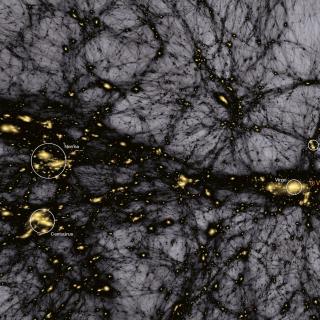Pellejero-Ibañez, Marcos; Balaguera-Antolínez, Andres; Kitaura, Francisco-Shu; Angulo, Raúl E.; Yepes, Gustavo; Chuang, Chia-Hsun; Reyes-Peraza, Guillermo; Autefage, Mathieu; Vakili, Mohammadjavad; Zhao, Cheng
Referencia bibliográfica
Monthly Notices of the Royal Astronomical Society
Fecha de publicación:
3
2020
Número de citas
21
Número de citas referidas
19
Descripción
We present a comparison between approximated methods for the construction of mock catalogues based on the halo-bias mapping technique. To this end, we use as reference a high-resolution N-body simulation of 38403 dark matter particles on a 400 h-1 Mpc cube box from the Multidark suite. In particular, we explore parametric versus non-parametric bias mapping approaches and compare them at reproducing the halo distribution in terms of the two- and three-point statistics down to ∼ 10^8 M_{☉ } h^{-1} halo masses. Our findings demonstrate that the parametric approach remains inaccurate even including complex deterministic and stochastic components. On the contrary, the non-parametric one is indistinguishable from the reference N-body calculation in the power spectrum beyond k=1 h Mpc^{-1}, and in the bispectrum for typical configurations relevant to baryon acoustic oscillation analysis. We conclude that approaches which extract the full bias information from N-body simulations in a non-parametric fashion are ready for the analysis of the new generation of large-scale structure surveys.
Proyectos relacionados

Cosmología con Trazadores de la Estructura a Gran Escala del Universo
El Fondo Cósmico de Microondas (FCM) contiene la información estadística de las semillas primigenias que han dado lugar a la formación de todas las estructuras en el Universo. Su contrapartida natural en el Universo local es la distribución de las galaxias que surgen como resultado del crecimiento gravitatorio de aquellas fluctuaciones de densidad
FRANCISCO SHU
KITAURA JOYANES